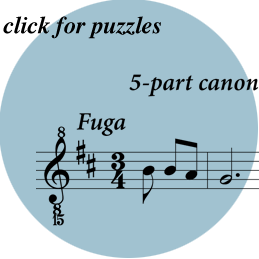This set of seven puzzle canons was conceived as a single composition
Who doesn't enjoy a little puzzle now and then? Bach did. The score to Seven Baroque Puzzles begins with seven single melodies and clues as to how each forms a piece for guitar ensemble. Five of the canons are solved by beginning each instrument at a specified interval higher or lower than the last; the other two can be solved as rounds, except that the melody may appear at any octave above or below the given part. Here quintuple counterpoint allows for a rich variety of harmonic interpretations, treating the ear to a rich tapestry of sound. Of course, following these cryptic puzzles in the score are actual arrangements of the puzzles for the quintet! For the optimal aural effect, the ensemble is directed to distribute themselves across the performance space so that the audience can fully experience the interplay of the parts.
This piece was conceived as a single composition in seven movements.
These are puzzle canons and as such belong to a centuries-long tradition. Customarily such pieces repeat, but it is up to the performers whether to actually follow repeats. In some cases it may seem natural to do so. In others, not.
In following with fugal tradition, dynamic levels are not included in the score. Every note is to be heard clearly.
Canons I through IV and canon VII are interval canons. Each successive entry begins a given distance above or below the previous voice. For example, in canon I, the second voice to enter falls a third lower than the previous voice’s first note.
Canons V and VI are more akin to rounds, but written in quintuple counterpoint, so that in solving the puzzle they may be transposed to any octave. For this reason, each part is confined to a small range. Notice that in these canons the upper voice or two is written in a different clef, indicating that it may be transposed an octave higher. This transposition is not necessary, but if taken, a more diverse and interesting texture will result.
With a little practice locating the beginnings (‘incipit’) and ending (‘fine’) within the repeats, these canons can be played from the score without page turns.
i. 5-part canon at the 3rd below in D major
ii. 5-part canon at the 4th above in A major
iii. 4-part canon at the 2nd above in A major (from Ænigmata Harmonia*)
iv. 4-part canon at the 2nd below in E major (from Ænigmata Harmonia*)
v. 5-part canon at any octave in B major
vi. 5-part canon at any octave in B minor
vii. 5-part canon at the 3rd below in D major
